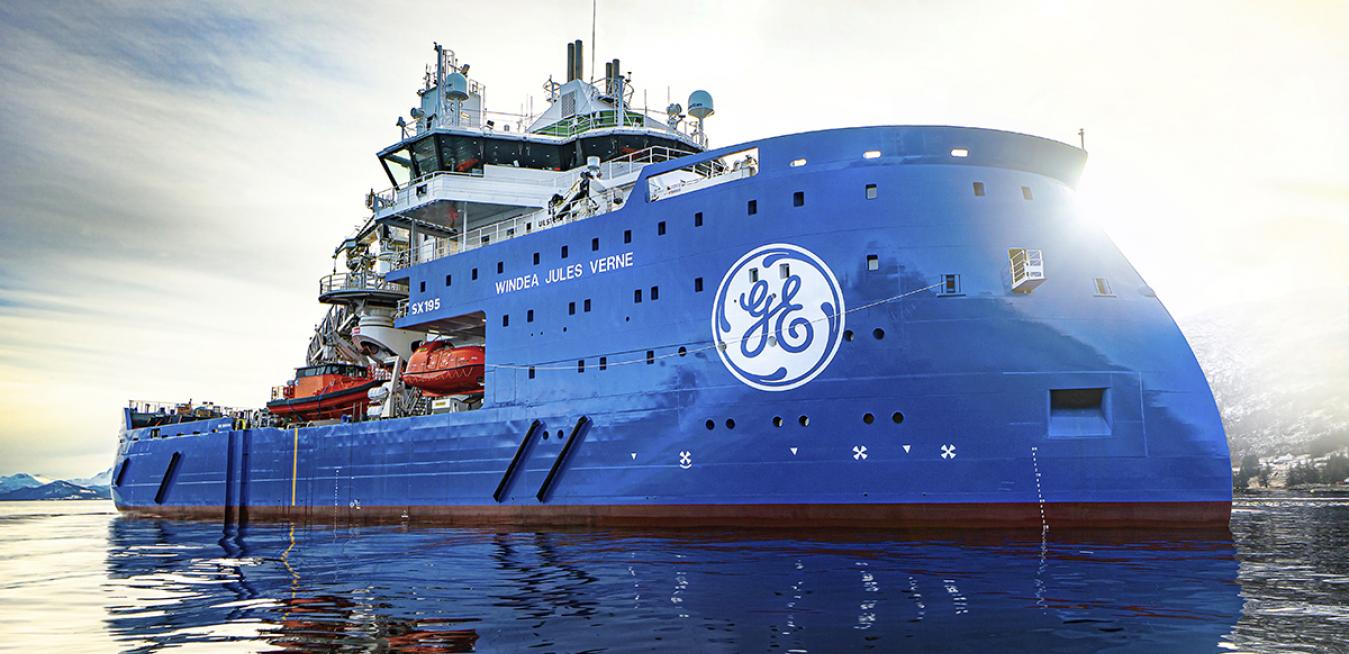SHIPSHAPE
If your car needs an oil change, you drop it off at the shop and pick it up later. Maintenance becomes an order of magnitude more difficult, though, when the machine in question is a powerful offshore wind turbine. Enter Brice Lavault — and the smart vessel that helps him do his job. A marine operations leader for GE Renewable Energy, Lavault works aboard the Windea Jules Verne, which sails from turbine to offshore turbine for maintenance and preventative work. The striking blue vessel, specifically designed for the GE business, plies the chilly waters of the North Sea, 55 kilometers off Germany, and the engineers who sail with it keep tabs on the Merkur Offshore Wind Farm — which comprises 66 GE Haliade 150-6MW turbines, capable of supplying up to 500,000 European homes.
In a league of its own: The ship is a mission control center, workshop and hotel in one, with room for a permanent 20-member crew and dozens more passengers, including engineers — and a whole lot of high-tech bells and whistles. Its positioning software, for instance, ensures that the vessel bobs safely at a 20-meter distance from each turbine tower; technicians move back and forth via a gangway that is “motion-compensated,” which is to say that it can telescope steer, and turn quickly to adjust. “It can deal with waves up to 2.5 meters of significant height and wind speeds of up to 20 meters per second, which are pretty extreme conditions,” Lavault said.
Learn more here about life at sea for a turbine technician.
SMART BUT HUMBLE
That modern-day artificial intelligence software packs a lot of computational firepower isn’t in dispute. But in recent years, scientists at GE Research have been trying to see if they can take AI beyond baseline smarts. They’re programming “humility,” for instance, so that when software runs into a situation it hasn’t been trained for — like when AI that continuously tweaks the angle of a wind turbine faces an unusual weather event — it can ask for help. And they’re programming “curiosity,” so AI software will seek out more data when it senses a shortfall. Wind turbines and other industrial applications are just the beginning of the potential for humble AI, though. It could also be part of an autonomous vehicle being designed specifically for the military.
Without a map: Recently the robotics team at GE Research teamed up with the U.S. Army on a new project. The goal? To develop a “brain” that will allow a small, four-wheeled vehicle outfitted with cameras and sensors to travel to a specified location through unmapped, rough terrain with roads or other infrastructure — and, ideally, without human intervention. “One of the biggest challenges to achieving such a mission is how we effectively handle uncertainty,” said Shiraj Sen, the GE Research roboticist who’s heading the team. That’s where humble AI comes in — the onboard brain in the vehicle will need to assess the risk it encounters out in the field, weigh it and choose the wisest path. “For autonomous systems to be truly useful, dealing with uncertainty is going to be the challenge, be it commercial — like self-driving cars — or military or industrial,” Sen said.
Learn more here about the Army’s Scalable, Adaptive and Resilient Autonomy program, and the potential of humble AI.
COOLEST THINGS ON EARTH ?
1. What The Knees Kneed
Researchers at Duke University formulated a hydrogel that’s as strong as human cartilage, and could offer an alternative to knee replacement surgery.
2. Space Protection Factor
Just as beachgoers slather on the SPF, space travelers could one day protect themselves from radiation with a new melanin-based biomaterial created by researchers at Northwestern University.
3. Strong As Silk
Japanese researchers used a photosynthetic bacteria to produce spider silk — an incredibly strong material with plenty of potential industrial applications.
Read more here about this week’s Coolest Things on Earth.
— QUOTE OF THE DAY —
“Our warfighters find themselves in very complex environments — they’re contested, they’re dangerous, they’re unstructured and there are a lot of unknowns. Our goal is to give them tools and teammates that better enable them to execute the mission at hand in a safer and more efficient manner.”
— John Lizzi, executive director for robotics at GE Research
Quote: GE Reports. Images: Ulstein Group.





